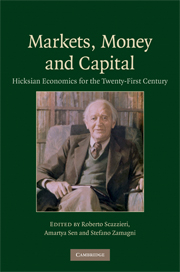Book contents
- Frontmatter
- Contents
- List of figures
- List of tables
- List of contributors
- Preface and acknowledgments
- Between theory and history: on the identity of Hicks's economics
- Part I The Intellectual Heritage of John Hicks
- Part II Markets
- Part III Money
- 11 Historical stylizations and monetary theory
- 12 Hicks: money, prices, and credit management
- 13 Core, mantle, and industry: a monetary perspective of banks' capital standards
- 14 A suggestion for simplifying the theory of asset prices
- Part IV Capital and Dynamics
- References
- Name index
- Subject index
11 - Historical stylizations and monetary theory
Published online by Cambridge University Press: 29 June 2009
- Frontmatter
- Contents
- List of figures
- List of tables
- List of contributors
- Preface and acknowledgments
- Between theory and history: on the identity of Hicks's economics
- Part I The Intellectual Heritage of John Hicks
- Part II Markets
- Part III Money
- 11 Historical stylizations and monetary theory
- 12 Hicks: money, prices, and credit management
- 13 Core, mantle, and industry: a monetary perspective of banks' capital standards
- 14 A suggestion for simplifying the theory of asset prices
- Part IV Capital and Dynamics
- References
- Name index
- Subject index
Summary
Introduction
John Hicks maintained that ‘a large part of the best work on Money is topical. It has been prompted by particular episodes, by particular experiences of the writer's own time’ (Hicks, 1967a: 156). The reason for this is that the principal goal of monetary theory is not ‘general understanding’ (that is, the discovery of principles uniformly applicable in a variety of times and places) but ‘particular understanding – an understanding directed towards a particular problem, normally a problem of the time at which the work in question is written’ (ibid.).
This focused character of monetary theory brings out an important association between monetary theory and monetary disturbances:
Monetary theories arise out of monetary disturbances. This is obviously true of the General Theory, which is the book of the Great Depression – the World Depression – of the nineteen-thirties; it is also true of Keynes's other version, the Treatise on Money, which differs from the General Theory quite largely because it is directed at a different contemporary problem. Though the Treatise was published in 1930, after the Depression had begun, it must largely have been written earlier. Its world is not the world of the Depression, it is the world of the Restored Gold Standard. Its problem is how the Restored Gold Standard is to be made to work.
(156–7)The topical character of monetary theory makes it especially sensitive to changes in monetary arrangements and institutions.
- Type
- Chapter
- Information
- Markets, Money and CapitalHicksian Economics for the Twenty First Century, pp. 185 - 203Publisher: Cambridge University PressPrint publication year: 2009
- 1
- Cited by

